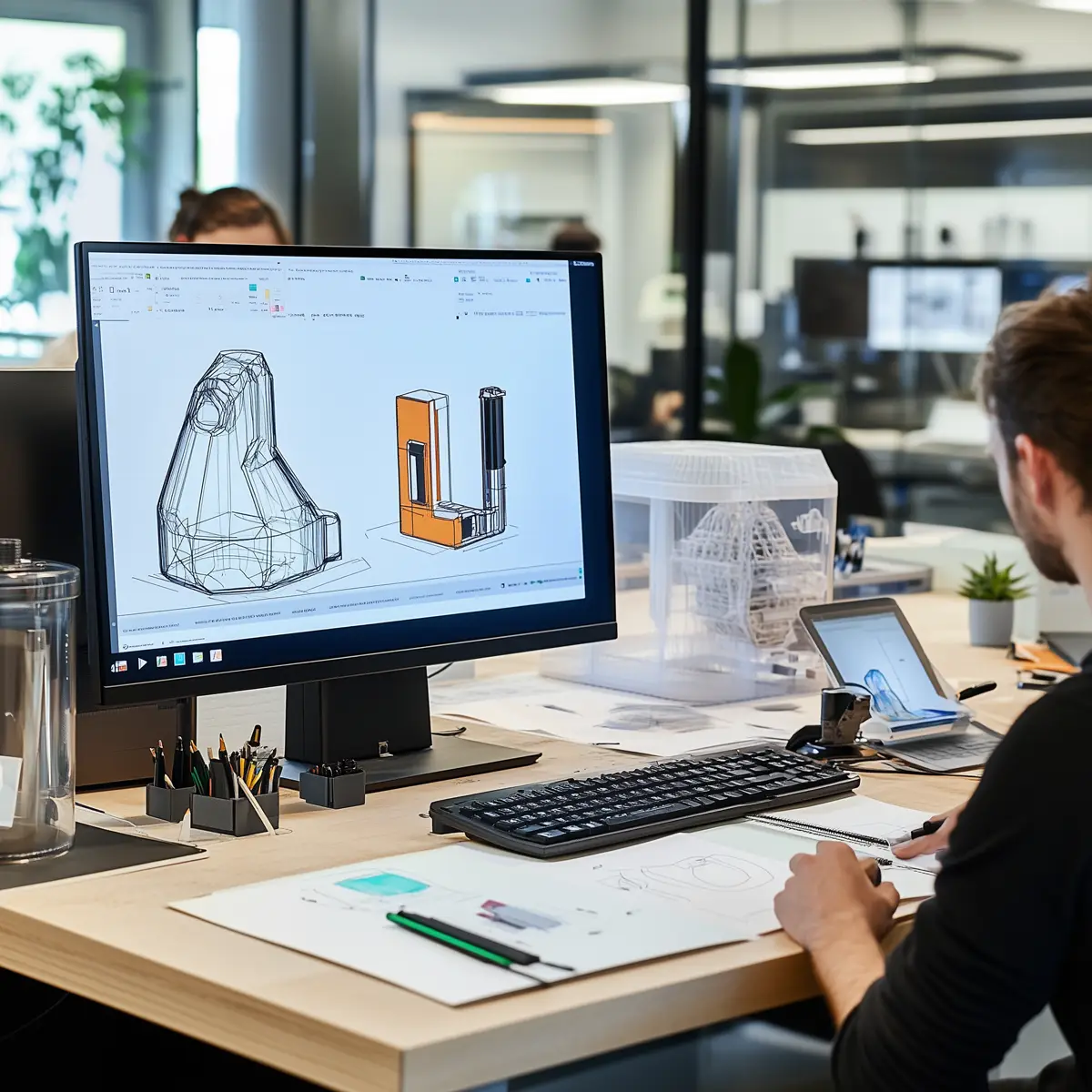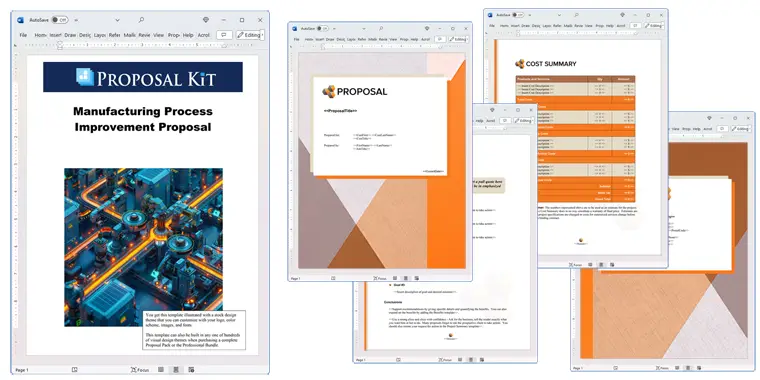How to write your Manufacturing Process Improvement Proposal
We include this 17 page layout with every Proposal Pack. If you want this template to have a different visual design theme than the one illustrated here, purchase any Proposal Pack design and create this template using the purchased design theme. This template is included in every Proposal Pack. If you get a Proposal Pack or the Professional, you can also make any variation of this template with different chapters to suit your needs.
We typically include more chapters in the templates than most people will need to give everyone more variety in the chapters they may need. You can trim down a long template by removing pages you do not need or combining multiple chapter topics into one page.
 DOWNLOADABLE, ONE-TIME COST, NO SUBSCRIPTION FEES
DOWNLOADABLE, ONE-TIME COST, NO SUBSCRIPTION FEES![]() View Manufacturing Process Improvement Sample Proposal
View Manufacturing Process Improvement Sample Proposal
This sample proposal is based on the same layout as this template and is included in every Proposal Pack. The visual design of the templates will match whichever Proposal Pack design you purchase. To get this template in a different design theme than shown in the sample, purchase any other Proposal Pack design theme and this template will be included.
You can create an editable Word version of this sample in any design theme of your choice including branded to your logo.
You can also create countless variations of this document to suit your needs using the included library of 2200+ chapters if ordering a Proposal Pack or Professional.
 What Our Clients Say
What Our Clients SayI am really glad that I bought the ProposalPack from your site. I actually bought it to use as a general reference tool because I didn’t really think that it was going to be as comprehensive as it actually is. The reaction from my existing clients has been great! They are very impressed with how detailed and professional my new business proposals are and the reaction from my future clients has been signed contracts. Thanks for creating such a valuable tool."
ACTIS
Related Article
Related Video
Related Templates
- Food Processing and Storage Services Proposal
- Beverage or Food Manufacturing Project Proposal
- Manufacturing and Distribution Proposal
- Relocate Manufacturing Domestic Proposal
- Reusable Component Design Proposal
- Welding and Fabrication Services Proposal
- Food Product Development Proposal
- Product Manufacturing Project Proposal
- Retooling Production Line Proposal
- Machining Services Proposal
- Product Manufacturer Proposal
- Vaccine Production and Distribution Proposal
- Testing and Inspection Services Proposal
- Product Manufacturing Moving Overseas Proposal
- Replacing Legacy Computer Systems Proposal
- Process Improvement Proposal
- Quality Assurance Project Proposal
- Automation of Facilities and Production Proposal
- Retraining Workers Skills Development Proposal
- AI Powered Domestic Manufacturing Proposal Template
- Collaborative Robotics Manufacturing Proposal Template
- Advanced Manufacturing Proposal Template
- Intelligent Factory Reshoring RFP Template
- Industrial Automation Proposal
- Manufacturing Proposal Template
What's the best way to write your manufacturing process improvement proposal?
A proven way to create a manufacturing process improvement proposal is using the Proposal Kit template and software package. This comprehensive tool offers a structured template to guide your proposal writing and integrates a line item quoting database system. This system assists in creating detailed cost summaries, quotes, estimates, budgets, and other financial documents crucial for a thorough proposal.
Are you tasked with proposing changes to improve manufacturing processes within your company? If so, the Proposal Kit is a proven solution.
What Types of Projects Are Manufacturing Process Improvement Proposals Written For?
Manufacturing process improvement proposals are created for various projects to enhance efficiency and productivity. Here are some common types of projects that such proposals are written for:
- Automation of Assembly Lines
- Integration of Robotics
- Upgrading Manufacturing Software Systems
- Implementing Lean Manufacturing Techniques
- Enhancing Supply Chain Management
- Reducing Material Waste
- Streamlining Packaging Processes
- Improving Quality Control Procedures
- Retrofitting Equipment for Energy Efficiency
- Enhancing Worker Safety Measures
- Introducing Just-In-Time Inventory Systems
- Developing Employee Training Programs
- Upgrading HVAC and Lighting Systems
- Implementing Continuous Improvement Programs
- Optimizing Facility Layouts
- Reducing Machine Downtime
- Increasing Production Speeds
- Expanding Manufacturing Capacities
- Introducing Predictive Maintenance Strategies
- Implementing Total Quality Management (TQM)
Chapters this template is built with
There isn't a one-size-fits-all template for manufacturing process improvement proposals, which is why Proposal Kit's software allows you to create custom variations to meet your specific needs. Starting from a base template, you can choose from thousands of chapter templates to tailor your proposal perfectly. Here's how you might use some of these templates:
Cover Letter
This introduces your proposal and sets the tone, summarizing why you are sending it and what you hope to achieve. For a manufacturing process improvement proposal, the cover letter could briefly explain the current inefficiencies and the anticipated benefits of the proposed changes. It serves as the first impression and should capture the recipient's attention.
Executive Summary
This provides a high-level overview of your proposal's main goals and the benefits of the proposed improvements. Considering the manufacturing situation, the executive summary should concisely explain the need for process improvements, the proposed solutions, and the expected outcomes, such as increased efficiency, cost savings, or enhanced product quality.
Needs Assessment
Detail the current manufacturing processes and identify areas needing improvement. This section should thoroughly analyze current operations, pinpoint inefficiencies, and highlight areas requiring upgrades. This could involve examining production timelines, labor utilization, and machinery performance.
Modernization
Describe the need for newer technologies or methods and how they can be implemented. This chapter should focus on the technological advancements or methodologies that can replace outdated systems. Discuss the benefits of automation, software upgrades, or the introduction of intelligent manufacturing systems to modernize the production line.
Observations
Record detailed observations that support the need for process improvements. This section includes data and insights from on-site inspections, employee feedback, and performance metrics. Observations should validate the issues identified in the needs assessment and provide a foundation for the proposed improvements.
Conversion Plan
Outline the steps necessary to transition from current processes to new ones. A well-structured plan should detail the timeline, resource allocation, and critical milestones for converting existing processes. This may involve pilot testing, employee training, and full-scale implementation.
Productivity Improvement
Explain how your changes will increase productivity and efficiency. This chapter should quantify the anticipated productivity gains, such as reduced cycle times, higher output rates, and decreased waste. Use specific metrics and benchmarks to illustrate the expected improvement.
Meetings
Plan detailed meetings to discuss and review the proposal's progress. Meetings are crucial for stakeholder engagement and project monitoring. Outline the schedule, objectives, and participants for each meeting, ensuring clear communication and timely decision-making throughout the project.
Efficiency
Discuss how the proposed changes will make the manufacturing process more efficient. This section should elaborate on the specific efficiency gains, such as streamlined workflows, optimized resource use, and improved machine uptime. Highlight how these efficiencies translate into cost savings and operational enhancements.
Budget
Provide a detailed budget that outlines all costs associated with the improvements. The budget should cover all expenses, including equipment purchases, software licenses, labor costs, and training programs. Ensure the budget is detailed and justified, clarifying how each cost contributes to the overall project goals.
Cost/Benefit Analysis
Analyze the costs of the proposed changes against the expected benefits. This chapter should present a thorough financial analysis, comparing the investment required for the improvements against the anticipated returns. Include calculations such as payback periods, return on investment (ROI), and net present value (NPV).
Recommendations
Offer a concise list of recommended actions based on the proposal's findings. Summarize the key actions that need to be taken to achieve the proposed improvements. Recommendations should be clear, actionable, and prioritized based on their impact and feasibility.
Project Process Summary
Summarize the entire project process from start to finish. This section should provide an overview of the project lifecycle, from initial planning and needs assessment to implementation and post-project evaluation. Ensure that all significant phases and activities are covered for a clear project roadmap.
Quality Control
Detail how quality will be managed and maintained during and after the improvements are implemented. Describe the quality control measures that will be implemented, including regular inspections, testing protocols, and continuous monitoring. Highlight how these measures ensure the improvements meet the desired standards and contribute to overall process reliability.
Use cases for this template
Streamlining Operations at a High-Tech Assembly Plant
The Challenge
Jane, a production manager at DynaTech Industries, faced a challenge as the company's productivity steadily declined. The outdated assembly line equipment frequently broke down, causing delays and increasing operational costs. The inefficiency affected both output and employee morale, making it imperative to propose a solution that could significantly improve the manufacturing process.
The Solution
Jane used the Proposal Kit to write a comprehensive proposal advocating for the modernization of the assembly line equipment and better integration of automation technologies. The Proposal Kit's extensive library of templates allowed her to include detailed sections on modernization, productivity improvement, and cost/benefit analysis. Jane developed a well-structured document outlining the benefits of adopting cutting-edge technologies and the anticipated return on investment.
The Implementation
Once the company's executives approved the proposal, Jane coordinated with various vendors to procure the new equipment. She also worked closely with internal teams to ensure a smooth transition from the old systems to the latest automated processes. Regular meetings were held to monitor progress, and any issues were promptly addressed.
The Outcome
Implementing the new systems led to a remarkable increase in productivity. The downtime due to equipment failure was significantly reduced, and the assembly line's efficiency improved. The successful project validated the proposal, boosted employee morale, and positioned DynaTech Industries as a forward-thinking company in the high-tech manufacturing sector.
Enhancing Efficiency Through Lean Training
The Challenge
Mike, a process improvement specialist at Efficient Manufacturing Solutions, was concerned about the company's adherence to lean manufacturing principles. Despite having lean strategies, many employees needed to follow them correctly, resulting in inefficiencies and elevated production costs. The challenge was finding a solution to improve the understanding and implementation of lean methodologies across the organization.
The Solution
Mike turned to Proposal Kit to create a detailed proposal for a comprehensive lean manufacturing training program. Leveraging the Proposal Kit's templates, he created sections on needs assessment, training plans, and a detailed budget. The proposal emphasized the importance of lean principles and how training would reduce wastage and increase productivity.
The Implementation
Upon receiving approval, Mike organized several training sessions, inviting lean manufacturing experts to conduct workshops. These sessions were designed to provide hands-on experience and practical insights into lean methodologies. Employees from different departments participated, ensuring a company-wide understanding of the principles and their application.
The Outcome
The training program reduced material wastage and significantly improved employee efficiency. The lean principles were better understood and correctly implemented, leading to smoother operations and lower costs. The training's success underscored the proposal's value and demonstrated the Proposal Kit's effectiveness in creating impactful internal project proposals.
Upgrading Safety Measures in Chemical Processing
The Challenge
Sarah, the safety manager at ChemiSafe Inc., was increasingly worried about the frequency of safety incidents in the chemical processing plant. The aging safety equipment was no longer reliable, and the protocols needed to be revised to handle emergencies effectively. It was crucial to propose upgrading the safety measures to protect employees and maintain compliance with safety regulations.
The Solution
Sarah used the Proposal Kit to write a proposal advocating for installing advanced safety equipment and improved emergency protocols. The templates provided by Proposal Kit enabled her to include comprehensive sections on needs assessment, safety modernization, budget, and quality control. The proposal highlighted the risks associated with outdated equipment and the benefits of investing in state-of-the-art safety systems.
The Implementation
After the proposal was approved, Sarah spearheaded the project to install new safety systems. She coordinated with suppliers to procure the latest safety equipment and organized training sessions for employees to familiarize themselves with the new protocols. Regular safety drills were conducted to ensure everyone was prepared for any emergencies.
The Outcome
The upgraded safety measures reduced safety incidents, significantly improving the working environment at ChemiSafe Inc. The company also received a safety award, acknowledging the enhanced safety standards. This validated the proposal and reinforced the importance of continuous improvement in safety protocols.
Conclusions and Recommendations
Using Proposal Kit, business professionals can address the complex demands of creating manufacturing process improvement proposals. From writing the initial document using specialized templates to managing financial assessments with an integrated quoting system, Proposal Kit provides all the tools to create comprehensive, persuasive proposals that lead to successful project approvals and implementations.
Also Known As
This template may also be referred to in different ways or be used in more specialized situations, such as:
- Manufacturing Efficiency Proposal
- Process Enhancement Plan
- Factory Improvement Proposal
- Production Optimization Strategy
- Industrial Process Upgrade Proposal
- Manufacturing Innovation Plan
- Operational Excellence Strategy
- Manufacturing Redesign Proposal
- Process Reengineering Plan
- Production Streamlining Proposal
Abstract
 Manufacturing process improvement is important for achieving long-term success and sustainability in today's competitive business environment. Companies seeking to optimize their manufacturing operations can benefit greatly from a well-structured process improvement plan. This involves using effective process improvement methods and business process management to enhance production processes, meet customer expectations, and ensure customer satisfaction.
Manufacturing process improvement is important for achieving long-term success and sustainability in today's competitive business environment. Companies seeking to optimize their manufacturing operations can benefit greatly from a well-structured process improvement plan. This involves using effective process improvement methods and business process management to enhance production processes, meet customer expectations, and ensure customer satisfaction.
A comprehensive process improvement plan example includes steps such as process mapping and identifying bottlenecks, weak points, and unnecessary steps, all of which are crucial for improving business processes. Additionally, by employing continuous process improvement strategies and practices like lean production and six sigma methodology, companies can achieve greater efficiency and higher productivity.
The main objective of these improvement initiatives is to reduce inefficiencies, eliminate waste, and maintain product quality. This requires the collaboration of a dedicated process improvement team and project managers who are adept at project management and can adapt to changing business needs. Using improvement strategies such as kaizen aims, and the plan-do-check-act cycle can lead to targeted improvements and sustainable advancements in manufacturing operations. By analyzing statistical data and customer complaints, businesses gain valuable insights into the root cause of issues and can address them.
 For manufacturers, incorporating new processes and technologies - such as automation and robotics - can boost efficiency and reduce overworked employees, ultimately improving overall efficiency. A process change is often necessary to keep up with company culture and meet customer expectations. By creating a customized process improvement plan template, businesses can ensure that their specific improvement process aligns with their goals for profitability and sustainability.
For manufacturers, incorporating new processes and technologies - such as automation and robotics - can boost efficiency and reduce overworked employees, ultimately improving overall efficiency. A process change is often necessary to keep up with company culture and meet customer expectations. By creating a customized process improvement plan template, businesses can ensure that their specific improvement process aligns with their goals for profitability and sustainability.
Using Proposal Kit can streamline the process of writing a manufacturing process improvement proposal. With its extensive content libraries and complex document assembly features, Proposal Kit aids in creating detailed cost summaries, quotes, and budgets, all crucial for developing a persuasive proposal. This structured approach helps businesses succeed in their improvement efforts, delivering the end product that customers demand while maximizing efficiency and reducing costs.
Expanding on the topic of manufacturing process improvement, it is crucial to emphasize the importance of a well-written process improvement plan. An effective process improvement plan is in addressing and solving the challenges faced by manufacturers. By using a combination of process improvement techniques and other process improvement methods, businesses can achieve sustainable improvements that enhance inventory management and overall efficiency on the shop floor. This approach is aligned with the Japanese philosophy of continuous improvement, or kaizen, which focuses on small-scale, incremental changes that lead to long-term success.
 Incorporating the scientific method to analyze data and track performance in real time allows project teams to identify problems and assess their impact swiftly. Total Quality Management (TQM) relies heavily on such methods to maintain consistency and eliminate errors, ensuring that finished products meet high standards. The plan-do-check-act cycle serves as a guide for continuously improving processes and establishing a flow of operations that reduce resistance and enhance productivity.
Incorporating the scientific method to analyze data and track performance in real time allows project teams to identify problems and assess their impact swiftly. Total Quality Management (TQM) relies heavily on such methods to maintain consistency and eliminate errors, ensuring that finished products meet high standards. The plan-do-check-act cycle serves as a guide for continuously improving processes and establishing a flow of operations that reduce resistance and enhance productivity.
A successful manufacturing process improvement proposal not only defines the end goal but also establishes the first steps necessary to achieve it. It requires the collaboration of team members and operators, using their expertise to communicate priorities and generate relevant solutions. Leadership plays a key role in determining the course of action and providing a sense of ownership over the process, which helps to overcome any resistance to change.
The use of Proposal Kit in creating these proposals brings a structured approach that guarantees the creation of comprehensive documents. Its extensive libraries and automated features allow for the generation of tailored proposals that address specific challenges, such as optimizing inventory management or eliminating waste. By focusing on the priorities set forth in the proposal, businesses can improve processes and ultimately increase sales and service quality.
 Establishing an effective process improvement plan is important. It helps businesses define their objectives, track improvements, and ensure that their operations are aligned with both current needs and future goals. With the right strategies and tools, companies can achieve a harmonious combination of efficiency and productivity, paving the way for long-term success and resilience in the global market.
Establishing an effective process improvement plan is important. It helps businesses define their objectives, track improvements, and ensure that their operations are aligned with both current needs and future goals. With the right strategies and tools, companies can achieve a harmonious combination of efficiency and productivity, paving the way for long-term success and resilience in the global market.
This plan acts as a roadmap, guiding organizations toward enhanced operational efficiency and long-term success. A significant part of such plans is the inclusion of Total Quality Management (TQM), which relies heavily on structured methodologies like the plan-do-check-act cycle. This cycle is fundamental in improving efficiency by providing a systematic approach to problem-solving and process optimization.
Drawing from the Japanese philosophy of kaizen, these improvements often start on a small scale, addressing one problem at a time to gradually build up to substantial enhancements. The idea is to foster continuous improvement through incremental changes that collectively drive significant progress. This approach aligns with the notion that small, consistent efforts can lead to major breakthroughs, especially when integrated into the company's culture and practices.
 Discussing process improvement should also highlight the three types of changes typically considered - process, product, and organizational - which encompass the various components needed for comprehensive progress. In this context, real-time data analysis is crucial for determining the impact of changes and ensuring that adjustments are made swiftly and. Leadership plays a role here, guiding the project team and ensuring that solutions are not only implemented but also aligned with the organization's goals.
Discussing process improvement should also highlight the three types of changes typically considered - process, product, and organizational - which encompass the various components needed for comprehensive progress. In this context, real-time data analysis is crucial for determining the impact of changes and ensuring that adjustments are made swiftly and. Leadership plays a role here, guiding the project team and ensuring that solutions are not only implemented but also aligned with the organization's goals.
The completion of process improvement initiatives often hinges on solving complex challenges, such as optimizing resource allocation or enhancing components of the supply chain. This may involve innovative hiring strategies to bring in the necessary expertise or adjusting existing workflows to maximize productivity. By addressing these areas, businesses can potentially unlock new levels of efficiency and resilience.
The integration of the Proposal Kit further supports these efforts by facilitating the creation of precise and compelling improvement proposals. By offering a structured framework for proposal development, these tools help articulate the needs, solutions, and expected outcomes in a manner that resonates with stakeholders and drives action. As organizations continue to evolve, the ability to adapt and implement effective process improvement plans remains a cornerstone of sustained competitiveness and success in the global market.
Frequently Asked Questions
What should a manufacturing process improvement proposal include?
A comprehensive manufacturing process improvement proposal should include several key elements to ensure it is persuasive and actionable. Start with a cover letter to introduce the proposal and set the stage. Follow this with an executive summary that provides a high-level overview of the proposal's objectives and anticipated benefits. A detailed needs assessment should then outline the current manufacturing processes and identify areas that require improvement. Financial sections such as budget estimates and a cost/benefit analysis are crucial for justifying the investment. Lastly, include specific recommendations, a project process summary, and a quality control plan to ensure all aspects of the improvement are covered.
How do I justify the need for improvements in my proposal?
Justifying the need for improvements in your manufacturing process improvement proposal requires solid data and well-documented observations. Begin by highlighting inefficiencies or problems in the current manufacturing process with quantitative data - such as downtime percentages, defect rates, or production speeds. These data points illustrate the negative impact on overall productivity and costs. Then, present the benefits of your proposed improvements using projections and comparisons. For example, if you suggest the integration of automation, show how it can reduce labor costs, increase production speed, and improve product quality.
How detailed should the budget be in my manufacturing process improvement proposal?
The budget section of your manufacturing process improvement proposal should be as detailed as possible to provide a clear financial picture. Break down costs into specific categories such as equipment, labor, training, and software. Include both initial investment costs and ongoing operational expenses. Detailed budget information helps stakeholders understand where funds will be allocated and prepare them for financial commitments. A thorough cost/benefit analysis within the budget section can further bolster the economic case for the proposed improvements.
What strategies can I employ to make my proposal stand out?
To make your manufacturing process improvement proposal stand out, focus on clarity, organization, and compelling data. Use a well-structured format with clear headings and subheadings to make the document easy to navigate. Incorporate visuals like charts and graphs to illustrate key points. Highlight the benefits of the proposed improvements in a way that aligns with the company's goals, such as increasing efficiency, reducing costs, or improving product quality. Leveraging tools like Proposal Kit can help ensure your proposal is professional and polished, increasing its chances of approval.
How can I ensure my proposal gets approved?
Ensuring your manufacturing process improvement proposal gets approved involves presenting a well-rounded, data-driven case. Address potential concerns upfront, such as the cost of implementation and the impact on current operations. Provide detailed timelines and project plans to demonstrate feasibility. Emphasize the long-term benefits and ROI of the proposed improvements. Engaging key stakeholders early in the process and seeking their input can also increase buy-in. A comprehensive tool like Proposal Kit can help you cover all bases, from financials to quality control, ensuring your proposal is thorough and compelling.
20% Off Discount
![]() Add To Cart This Word Template
Add To Cart This Word Template
 Add To Cart Proposal Pack Contemporary #18
Add To Cart Proposal Pack Contemporary #18
 Add To Cart Proposal Kit Professional
Add To Cart Proposal Kit Professional
 4.7 stars, based on 849 reviews
4.7 stars, based on 849 reviewsProposal Kit chapters used in this template
Cover Letter, Title Page, Table of Contents, Executive Summary, Needs Assessment, Observations, Modernization, Efficiency, Productivity Improvement, Quality Control, Conversion Plan, Meetings, Project Process Summary, Budget, Cost/Benefit Analysis, Recommendations, Back Page
Line Item Automated Chapters
If you purchase a Proposal Pack or the Professional Bundle, these proposal pages are generated using an automated line-item database in the included Wizard software.
Budget Three Year, Cost Benefit Analysis
You use this proposal for
- Non-technical proposal
- Project pitch proposal
- Internal company proposal
- Manufacturing, engineering, fabrication proposal
How to create this template with Proposal Pack Wizard
You can create this document using any of the logo-designed Proposal Packs. Pick any Proposal Pack with a logo design theme you like best; they will all work equally well. The Proposal Pack for Any Business is the pack with no extra added logos or colors - designed to be used plain or for you to customize with your logos and graphics.
The Proposal Pack design theme you purchase will determine the visual look of this template. The screenshot above only shows the plain generic design theme.
We include a library of chapters to be assembled based on your needs. All proposals are different and have different needs and goals. We designed Proposal Pack so you can customize the documents to suit your needs.
You will best create this document using the Proposal Pack Wizard - Expert Edition software to select this template and build it in the Proposal Pack logo design theme of your choice along with any desired customizations (such as adding additional chapters, removing unneeded chapters, changing the order of chapters, and importing your company logo). This template outlines a proposal for the described situation. Each user is responsible for typing in the actual content of the provided pages with their information to complete the proposal. Suggestions in the abstract may include features in higher-end packages and are facilitated by the selection of chapter templates to support the narrative of each proposal, which help guide the user in filling in the details.
The Wizard software's AI Writer will write the content of the pages of the template based on details provided for your company, client, project, financial details and other writing instructions. This will provide a personalized version of the template completely written and ready to edit.
Once finished, the AI Writer's Word-to-PowerPoint converter can transform your proposal, business plan, or other business documents into a PowerPoint slideshow. Save time and effort by letting the AI analyze every chapter to condense its content into talking points, visually matching the document, and providing a consistent package of presentation material with the click of a button.
You create this template using the Wizard software with an entire Proposal Pack library and software. We include the Expert Edition of the software in the Proposal Kit Professional. Microsoft Word for Windows is required to use the customizing software. You can also edit Word document templates in other office software such as Word for Mac. We will assist Mac users in assembling complex templates for their first project if they do not have the required platform to run the Wizard software.
How to Build Templates Featured on Proposal Kit Website
Many people find the Proposal Kit website after searching for a specific proposal. Once you've purchased and installed the software, how do you build that template you found in the first place? This video shows you how to build any proposal you see on the Proposal Kit website.
 Ian Lauder has been helping businesses write their proposals and contracts for two decades. Ian is the owner and founder of Proposal Kit, one of the original sources of business proposal and contract software products started in 1997.
Ian Lauder has been helping businesses write their proposals and contracts for two decades. Ian is the owner and founder of Proposal Kit, one of the original sources of business proposal and contract software products started in 1997.By Ian Lauder
 Published by Proposal Kit, Inc.
Published by Proposal Kit, Inc.


 Cart
Cart
 Get 20% off ordering today:
Get 20% off ordering today: 


 Facebook
Facebook YouTube
YouTube Bluesky
Bluesky Search Site
Search Site